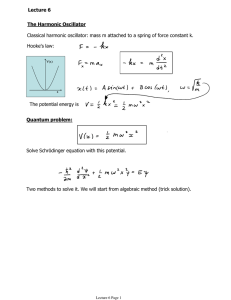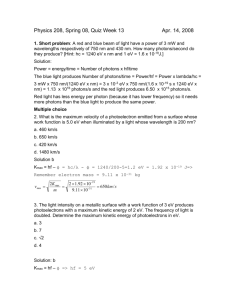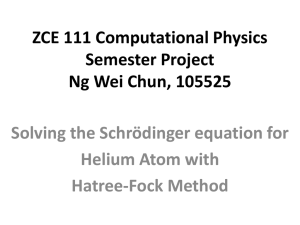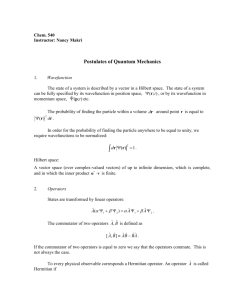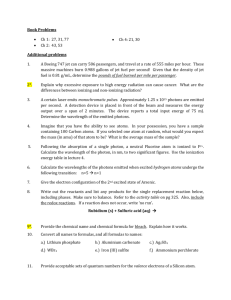Lecture 2. Quantization
advertisement
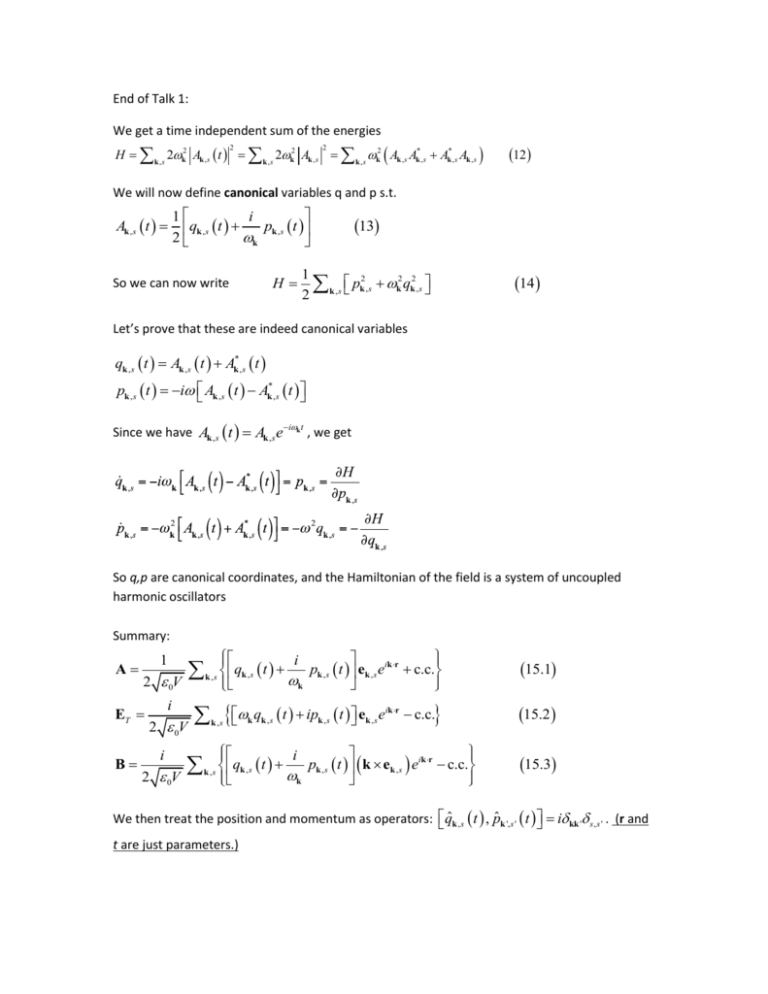
End of Talk 1:
We get a time independent sum of the energies
H k , s 2k2 Ak , s t k , s 2k2 Ak , s k , s k2 Ak , s Ak*, s Ak*, s Ak , s
2
2
12
We will now define canonical variables q and p s.t.
1
i
pk , s t
qk , s t
2
k
Ak , s t
H
So we can now write
13
1
pk2,s k2 qk2,s
2 k ,s
14
Let’s prove that these are indeed canonical variables
qk , s t Ak , s t Ak*, s t
pk , s t i Ak , s t Ak*, s t
Since we have Ak , s t Ak ,s eik t , we get
So q,p are canonical coordinates, and the Hamiltonian of the field is a system of uncoupled
harmonic oscillators
Summary:
A
1
2
ET
B
V
k ,s
0
i
2 0V
q t ip t e
k ,s
i
2
V
0
i
pk , s t ek , s eik r c.c.
qk , s t
k
k ,s
k
k ,s
k ,s
k ,s
eik r c.c.
i
pk , s t k ek , s eik r c.c.
qk , s t
k
15.1
15.2
15.3
We then treat the position and momentum as operators: qˆk , s t , pˆ k ', s ' t i kk ' s , s ' . (r and
t are just parameters.)
Talk 2:
𝑨(𝒓, 𝑡) =
𝑩(𝒓, 𝑡) =
1
2√𝜀0 𝑉
𝑖
2√𝜀0 𝑉
𝑬(𝒓, 𝑡) =
∑ {[ 𝑞𝒌,𝒔 (𝑡) +
𝒌,𝒔
∑ {[ 𝑞𝒌,𝒔 (𝑡) +
𝒌,𝒔
𝑖
2√𝜀0 𝑉
𝑖
𝑝 (𝑡)]𝜺𝒌,𝒔 𝑒 𝑖𝒌∙𝒓 + 𝑐. 𝑐. }
𝜔𝑘 𝒌,𝒔
𝑖
𝑝 (𝑡)](𝒌 × 𝜺𝒌,𝒔 )𝑒 𝑖𝒌∙𝒓 − 𝑐. 𝑐. }
𝜔𝑘 𝒌,𝒔
∑{[𝜔𝑘 𝑞𝒌,𝒔 (𝑡) + 𝑖 𝑝𝒌,𝒔 (𝑡)]𝜺𝒌,𝒔 𝑒 𝑖𝒌∙𝒓 − 𝑐. 𝑐. }
𝒌,𝒔
1
1
1
2
2
(𝑡) + 𝑝𝒌,𝒔
(𝑡) ]
𝐻 = ∫ 𝑑𝑣 [𝜀0 𝑬(𝒓, 𝑡)2 + 𝑩(𝒓, 𝑡)2 ] = ∑[ 𝜔𝑘2 𝑞𝒌,𝒔
2
𝜇0
2
𝒌,𝒔
This is exactly harmonic oscillator, with q,p playing the roles of the momentum and position.
This is the most “natural” harmonic oscillator, since no medium is required.
{Siren vs Chk = Relativity !}
Harmonic means amplitude doesn’t change frequency {Newton, recorder vs guitar}
After quantization this will mean equal units of energy ℏ𝜔 - which are the photons
We therefore make the natural assumption that q,p are Fourier-related, and thus do not commute (at
equal times):
3
[ 𝑞̂𝒌,𝒔 (𝑡) , ̂𝑝𝒌′ ,𝒔′ (𝑡)] = 𝑖ℏ𝛿𝑘𝑘
′ 𝛿𝑠𝑠′
[ 𝑞̂𝒌,𝒔 (𝑡) , ̂𝑞𝒌′ ,𝒔′ (𝑡)] = 0
[ 𝑝̂𝒌,𝒔 (𝑡) , ̂𝑝𝒌′ ,𝒔′ (𝑡)] = 0
NOTE that we are automatically start in the Heisenberg Picture – i.e. the operators change with time
Define:
𝑎̂𝒌,𝒔 (𝑡) =
†
𝑎̂𝒌,𝒔
(𝑡) =
1
√2ℏ𝜔𝑘
1
√2ℏ𝜔𝑘
(𝜔𝑘 𝑞̂𝒌,𝒔 (𝑡) + 𝑖 𝑝̂𝒌,𝒔 (𝑡))
(𝜔𝑘 𝑞̂𝒌,𝒔 (𝑡) − 𝑖 𝑝̂ 𝒌,𝒔 (𝑡))
And then (HW easy):
†
(𝑡)] = 1
[𝑎̂𝒌,𝒔 (𝑡), 𝑎̂𝒌,𝒔
And:
1
†
̂ = ∑ ℏ𝜔𝑘 [ 𝑎̂𝒌,𝒔
(𝑡)𝑎̂𝒌,𝒔 (𝑡) + ]
𝐻
2
𝒌,𝒔
We’ll see soon that’s it is a sum over all photons, that the Hermitian (and so – observable)
operator:
†
†
̂𝒌,𝒔
(𝑡) = 𝑎̂𝒌,𝒔
(𝑡)𝑎̂𝒌,𝒔 (𝑡)
𝑁
simply counts the photons in the k,s mode
, multiplying each by the unit energy ℏ𝜔𝑘 :
1
†
̂ = ∑ ℏ𝜔𝑘 [𝑁
̂𝒌,𝒔
(𝑡) + ]
𝐻
2
𝒌,𝒔
The
ℏ𝜔𝑘
2
is the “vacuum energy” !!, left in each mode even when there are no photons left..
Responsible for so many things – Casimir, Shot noise, and perhaps the acceleration of the
universe? (any cosmologists around?)
But first let’s see why we claim there are photons:
DISCLAIMER: FROM NOW ON – we drop the k,s, and deal with each mode separately – until we
discuss nonlinear phenomena, the modes do not interact anyway, and we’ll deal with non-plane
waves, that are a LINEAR combination of different k’s later on. We’ll also ignore the time
dependence for a while – look at some t=0. Since we’re in the Heisenberg picture, once we
know how the operators change with time, we’ll know everything.
̂(𝑡) , |𝑛⟩ , with eignvalues 𝑛
Look at the eignvectors of the Operator 𝑁
̂ (𝑡)|𝑛⟩ = 𝑛|𝑛⟩
𝑁
̂ is obviously
I say nothing of 𝑛 YET – only that they exist, and are observable and real (since 𝑁
Hermitian) and obviously positive <>. They are also eignvectors of the Hamiltonian:
̂ |𝑛⟩ = 𝐸𝑛 |𝑛⟩,
𝐻
1
𝐸𝑛 = ℏ𝜔 (𝑛 + )
2
Let’s look at the state 𝑎̂† |𝑛⟩ : we’ll multiply from the left with 𝑎̂† :
̂ |𝑛⟩ = 𝑎̂† 𝐸𝑛 |𝑛⟩
𝑎̂† 𝐻
From the commutation relations (note what they mean):
[𝑎̂, 𝑎̂† ] = 1
→ 𝑎̂𝑎̂† − 𝑎̂† 𝑎̂ = 1
→ 𝑎̂𝑎̂† = 𝑎̂† 𝑎̂ + 1 ,
𝑎̂† 𝑎̂ = 𝑎̂𝑎̂† − 1
So:
̂ |𝑛⟩ = 𝑎̂† 𝐸𝑛 |𝑛⟩
𝑎̂† 𝐻
1
ℏ𝜔 (𝑎̂† 𝑎̂† 𝑎̂ + 𝑎̂† ) |𝑛⟩ =
2
1
ℏ𝜔 (𝑎̂† (𝑎̂𝑎̂† − 1 ) + 𝑎̂† ) |𝑛⟩
2
1
ℏ𝜔 (𝑎̂† 𝑎̂ 𝑎̂† − 𝑎̂† ) |𝑛⟩ =
2
1
1
ℏ𝜔 (𝑎̂† 𝑎̂ − ) 𝑎̂† |𝑛⟩ = ℏ𝜔 (𝑛 + ) 𝑎̂† |𝑛⟩
2
2
Add to both sides: ℏ𝜔 𝑎̂ † |𝑛⟩
1
1
̂ 𝑎̂† |𝑛⟩ = ℏ𝜔 (𝑛 + + 1) 𝑎̂† |𝑛⟩ = 𝐸𝑛+1 𝑎̂† |𝑛⟩
ℏ𝜔 (𝑎̂† 𝑎̂ + ) 𝑎̂† |𝑛⟩ = 𝐻
2
2
i.e:
𝑎̂† |𝑛⟩ is an eignvector of the Hamiltonian, i.e.
𝑎̂† |𝑛⟩ = 𝐶𝑛+ |𝑛 + 1⟩ !!
CREATES one more unit energy of ℏ𝜔 in the mode
Similarly we can show:
𝑎̂|𝑛⟩=𝐶𝑛− |𝑛 − 1⟩ (HW)
ANNIHILATES one more unit energy of ℏ𝜔 in the mode
That’s why they’re called the creation and annihilation operators – they create and annihilate a
Photon - THIS is a photon – no more, no less – a unit of energy in an E/O mode.
̂ = 𝑎̂† 𝑎̂ is positive, it can not have a negative eignvalue. Since we proved that 𝑎̂|𝑛⟩
Since 𝑁
creates from |𝑛⟩ (who’s eignvalue is n) a new eignvector with lower eignvalue n-1, the only
̂ is positive is that the eignvalues n are ROUND NUMBERS, so there
solution to how come 𝑁
MUST be the zero eign state: |0⟩
..and this is the VACUUM state
So now we know what a PHOTON is ! WHAT AN ACHIEVEMENT! INDEED hw, AND IT DOES
NOT CONTRADICT MAXWELL – IT CAME FROM IT! IT DOES NOT GIVE RISE TO WAVE PARTICLE
DUALITY – IT SOLVES IT
Let’s find the exact coefficients:
𝑎̂|𝑛⟩=𝐶𝑛− |𝑛 − 1⟩
We normalize: ⟨𝑛|𝑛⟩ = 1, and so:
̂|𝑛⟩ = ⟨𝑛|𝑎̂† 𝑎̂|𝑛⟩ = (𝐶𝑛− )∗ 𝐶𝑛− ⟨𝑛 − 1|𝑛 − 1⟩ = |𝐶𝑛− |2
𝑛 = ⟨𝑛|𝑁
→ 𝐶𝑛− = √𝑛
So:
𝑎̂|𝑛⟩=√𝑛|𝑛 − 1⟩
And
̂|𝑛 + 1⟩ = ⟨𝑛 + 1|𝑎̂† 𝑎̂|𝑛 + 1⟩ = √𝑛 + 1√𝑛 + 1⟨𝑛|𝑛⟩ = |𝐶𝑛+ |2
𝑛 + 1 = ⟨𝑛 + 1|𝑁
𝑎̂† |𝑛⟩ = √𝑛 + 1|𝑛 + 1⟩
The states |𝑛⟩ , which are states with exactly n units of energy = photons in the mode (k,s), are
called Fock states. Note that the state |𝑛⟩ can be created by repeated applications of the
operator 𝑎̂† on the vacuum state:
𝑛
|𝑛⟩ =
(𝑎̂† )
√𝑛!
|0⟩
, and they are all orthonormal – we know that ⟨𝑛|𝑛⟩ = 1, and it’s easy to show (show !) that
⟨𝑛|𝑚⟩ = 𝛿𝑚𝑛
THIS IS the Fock state basis, in which the creation and annihilation operators take the following
matrix forms:
0 √1
𝑎̂ = 0 0
0 0
0
√2
0
0
𝑎̂ = √1
0
†
0 0
0 0
√2 0
Obvious even to me
Now that we know enough about 𝑎̂, 𝑎̂† we can substitute them in the expressions for the fields
– WE PUT BACK THE TIME DEPENDENCE WE IGNORED IN THE LAST DERIVATIONS
Substituting:
ℏ
†
̂ (𝒓, 𝑡) = ∑ √
(𝑡)𝑒 −𝑖𝒌∙𝒓 } 𝜺𝒌,𝒔
𝑨
{𝑎̂ (𝑡)𝑒 𝑖𝒌∙𝒓 + 𝑎̂𝒌,𝒔
2𝜔𝑘 𝜀0 𝑉 𝒌,𝒔
𝒌,𝒔
ℏ𝜔
†
̂ (𝒓, 𝑡) = 𝑖 ∑ √ 𝑘 {𝑎̂𝒌,𝒔 (𝑡)𝑒 𝑖𝒌∙𝒓 − 𝑎̂𝒌,𝒔
(𝑡)𝑒 −𝑖𝒌∙𝒓 } 𝜺𝒌,𝒔
𝑬
2𝜀0 𝑉
𝒌,𝒔
ℏ
†
̂ (𝒓, 𝑡) = 𝑖 ∑ √
(𝑡)𝑒 −𝑖𝒌∙𝒓 }(𝒌 × 𝜺𝒌,𝒔 )
𝑩
{𝑎̂𝒌,𝒔 (𝑡)𝑒 𝑖𝒌∙𝒓 − 𝑎̂𝒌,𝒔
2𝜔𝑘 𝜀0 𝑉
𝒌,𝒔
Specifically, we usually deal with the electric field, since it is the one that couples strongly to the
electron in “optics” = optical frequencies, and B is “weaker” by 1/c and interacts through the
spin of the electron, so we focus on E.
For all the fields, it is convenient to separate:
̂ (𝒓, 𝑡) = 𝑬
̂ + (𝒓, 𝑡) + 𝑬
̂ − (𝒓, 𝑡)
𝑬
ℏ𝜔
̂ + (𝒓, 𝑡) = 𝑖 ∑ √ 𝑘 𝑎̂𝒌,𝒔 (𝑡)𝑒 𝑖𝒌∙𝒓 𝜺𝒌,𝒔
𝑬
2𝜀0 𝑉
𝒌,𝒔
†
ℏ𝜔
†
̂ − (𝒓, 𝑡) = (𝑬
̂ + (𝒓, 𝑡)) = −𝑖 ∑ √ 𝑘 𝑎̂𝒌,𝒔
(𝑡)𝑒 −𝑖𝒌∙𝒓 𝜺𝒌,𝒔
𝑬
2𝜀0 𝑉
𝒌,𝒔
VERY annoying the +/-, but they did not ask me.
How do they change with time? Like every operator:
1
†
̂ = ∑ ℏ𝜔𝑘 [ 𝑎̂𝒌,𝒔
(𝑡)𝑎̂𝒌,𝒔 (𝑡) + ]
𝐻
2
𝒌,𝒔
𝑑 (𝑎̂𝒌,𝒔 (𝑡))
𝑑𝑡
=
=
𝑖
̂ , 𝑎̂𝒌,𝒔 (𝑡)]
[𝐻
ℏ
𝑖
†
̂𝒌,𝒔
∗ ℏ𝜔𝑘 [𝑁
, 𝑎̂𝒌,𝒔 (𝑡)]
ℏ
and since
[𝑎̂, 𝑎̂† ] = 1
→ 𝑎̂𝑎̂† − 𝑎̂† 𝑎̂ = 1
→ 𝑎̂𝑎̂𝑎̂† − 𝑎̂𝑎̂† 𝑎̂ = 𝑎̂
̂] = 𝑎̂
→ [𝑎̂, 𝑁
𝑑 (𝑎̂𝒌,𝒔 (𝑡))
𝑑𝑡
= −𝑖𝜔𝑘 𝑎̂𝒌,𝒔 (𝑡)
→ 𝑎̂𝒌,𝒔 (𝑡) = 𝑎̂𝒌,𝒔 (0)𝑒 −𝑖𝜔𝑘 𝑡
and
†
†
(𝑡) = 𝑎̂𝒌,𝒔
(0)𝑒 𝑖𝜔𝑘 𝑡
𝑎̂𝒌,𝒔
SO:
ℏ𝜔
̂ + (𝒓, 𝑡) = 𝑖 ∑ √ 𝑘 𝑎̂𝒌,𝒔 (0)𝑒 𝑖(𝒌∙𝒓−𝜔𝑘 𝑡) 𝜺𝒌,𝒔
𝑬
2𝜀0 𝑉
𝒌,𝒔

